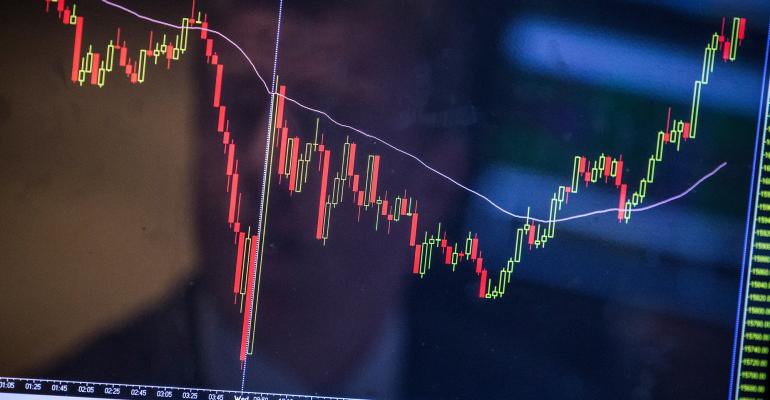(Bloomberg) -- A new breed of exchange-traded funds that hide their holdings has been slow to win over fans this year. That may change in 2021.
Assets in the active non-transparent category -- known as ANTs -- could reach $3 billion by the end of next year, Bloomberg Intelligence predicts. The funds have only attracted about $800 million so far, but companies that license the methodology hold a collective $1 trillion in assets, indicating a huge potential for growth.
Since launching in April as the coronavirus upended global markets, many of the ANT funds have outperformed peers, showcasing active managers who offer their strategies in an ETF wrapper without revealing all their secrets. They’ve had to overcome investors’ desire for transparency, varied performance records and, of course, a global pandemic.
“It’s really allowed a lot of other firms in the managed-fund industry to come in and offer their strategies in a different vehicle,” said Matthew Bartolini, head of SPDR Americas Research at State Street Global Advisors. “The outlook for 2021 hinges on the performance of all active strategies whether they’re transparent or non-transparent.”
There are signs that all active funds are starting to make headway in a world dominated by passive products. While active funds make up only 3% of the total $5.3 trillion U.S. ETF market, they are on pace for their best year of inflows on record.
Strong Starts
American Century became the first firm to release active non-transparent funds in April, debuting one tailored to growth strategies and another to value. The firm’s Focused Dynamic Growth ETF (FDG) has added more than $200 million in assets since its launch.
Offerings from Fidelity Investments Inc., Natixis SA and T. Rowe Price Group Inc. also came to market, while Invesco Ltd. received a nod from the Securities and Exchange Commission to move forward with its own model, probably launching in 2021.
“There are advantages of the ANT versus the mutual fund where you can offer the strategy at a lower cost, and it’s likely to be more tax efficient,” said David Perlman, an ETF strategist at UBS Global Wealth Management.
Out the 15 ANTs on the market, 10 are surpassing their benchmarks, Bloomberg Intelligence analysts Athanasios Psarofagis and Morgan Barna wrote in their report earlier this month. The current products represent just 0.3% of the amount held by their firms’ similar mutual funds.
Marketing Hurdles
One of the biggest hurdles for the new funds was always going to be marketing them and convincing investors of their added value, Perlman said. The remote work environment this year has made that task even more difficult, as video calls replace in-person meetings and networking events ground to a halt.
“You’re going to have to go out to those mutual-fund investors and educate them on the advantages of the ANT structure and potentially even get them comfortable with ETFs in general,” he said.
Persuading customers to accept less transparency in their funds and the higher price tag that ANTs charge is key. For instance, the Fidelity Blue Chip Growth ETF (FBCG) costs 0.59% compared to 0.04% for the Vanguard Growth ETF (VUG).
“They’re sold, not bought,” said Ben Slavin, head of ETFs for BNY Mellon Asset Servicing. “It’s much different than just tossing out a thematic ETF where it’s very clear what it is.”
Michael Winter, founder of Leatherback Asset Management, who recently launched his first ETF in the traditional format, isn’t convinced there’s much demand for ANTs in general.
“I hate to burst the ego of the star manager, but quite frankly I don’t think the investors are that concerned about what that star manager does on a day-to-day basis,” he said. “I don’t see the need for the ANT wrapper. I read, ‘oh it’s our secret sauce.’ There’s not an investor out there that says, ‘I want this ETF to be more opaque, give me less disclosure, give me less transparency.’”
Performance Watch
Of course, what could win over investors is outsized returns from stock pickers’ skills in navigating rapidly changing markets as vaccine deployment reignites the U.S. economy.
One of the top-performing ANTs so far is American Century’s growth fund FDG, which is up 89% since its debut in April compared to 45% for the S&P 500 during that same time period.
The recent rotation into value and cyclical strategies has benefited ANTs focused on value as well, with the Fidelity Blue Chip Value ETF (FBCV) up 15% since the beginning of November. That’s better than the S&P’s gain of 12% but on par with the passive, cheaper Vanguard Value ETF (VTV).
It’s also hard to argue for an active manager’s need for a shielded portfolio amid Cathie Wood’s continued success at Ark Investment Management, running three of the top 10 performing ETFs this year, all fully transparent.
Still, the availability of an ETF wrapper for active managers’ strategies could mean more new entrants into the space in 2021. Capital Group, JPMorgan Chase & Co. and Goldman Sachs Group Inc. have all licensed the ANT structure.
“People generally value transparency, but the trade-off is the potential for better performance or differentiated performance,” said Sal Bruno, chief investment officer of IndexIQ. “You’re buying into the skill level of the active manager. To get that, there’s a trade-off.”





